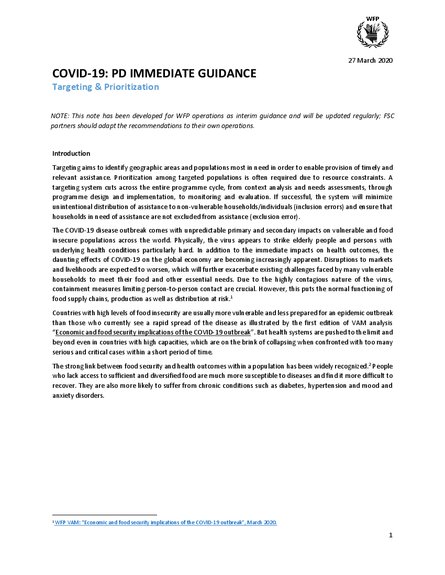
Targeting aims to identify geographic areas and populations most in need in order to enable provision of timely and relevant assistance. Prioritization among targeted populations is often required due to resource constraints. A targeting system cuts across the entire programme cycle, from context analysis and needs assessments, through programme design and implementation, to monitoring and evaluation. If successful, the system will minimize unintentional distribution of assistance to non-vulnerable households/individuals (inclusion errors) and ensure that households in need of assistance are not excluded from assistance (exclusion error).
The COVID-19 disease outbreak comes with unpredictable primary and secondary impacts on vulnerable and food insecure populations across the world. Physically, the virus appears to strike elderly people and persons with underlying health conditions particularly hard. In addition to the immediate impacts on health outcomes, the daunting effects of COVID-19 on the global economy are becoming increasingly apparent. Disruptions to markets and livelihoods are expected to worsen, which will further exacerbate existing challenges faced by many vulnerable households to meet their food and other essential needs. Due to the highly contagious nature of the virus, containment measures limiting person-to-person contact are crucial. However, this puts the normal functioning of food supply chains, production as well as distribution at risk.
Countries with high levels of food insecurity are usually more vulnerable and less prepared for an epidemic outbreak than those who currently see a rapid spread of the disease as illustrated by the first edition of VAM analysis “Economic and food security implications of the COVID-19 outbreak”. But health systems are pushed to the limit and beyond even in countries with high capacities, which are on the brink of collapsing when confronted with too many serious and critical cases within a short period of time. The strong link between food security and health outcomes within a population has been widely recognized. People who lack access to sufficient and diversified food are much more susceptible to diseases and find it more difficult to recover. They are also more likely to suffer from chronic conditions such as diabetes, hypertension and mood and anxiety disorders.